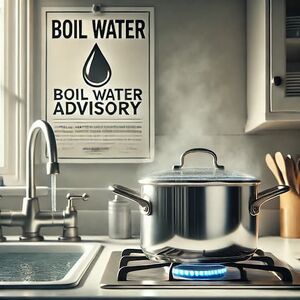Main Page
Boil Water Order
A boil water order, also known as a boil water advisory or boil water notice, is an official directive issued by local health or environmental authorities to inform the public that the municipal water supply may be contaminated with harmful pathogens or chemicals. This advisory is typically enacted in response to incidents such as microbial contamination, chemical spills, infrastructure damage, or natural disasters that compromise water safety.
Under a boil water order, residents are required to boil water for a specified period—usually bringing it to a rolling boil for at least one minute—to kill harmful microorganisms before using it for drinking, cooking, or personal hygiene. In addition to boiling, authorities may recommend using alternative water sources, such as bottled water, for critical uses. Compliance with boil water orders is essential to prevent waterborne illnesses and ensure public health until the water supply is deemed safe.

Key Actions During a Boil Water Order
- Boiling Water: Heat water to a rolling boil for the recommended duration.
- Using Bottled Water: Utilize commercially bottled water for drinking and cooking.
- Adjusting Household Practices: Modify activities like brushing teeth, washing dishes, and preparing food to use treated or alternative water sources.
- Storing Boiled Water Safely: Keep boiled water in clean, sealed containers to prevent recontamination.
- Staying Informed: Follow updates from local authorities and adhere to their guidelines until the order is lifted.
Boil water orders are critical public health measures that help mitigate the risks associated with contaminated water supplies, ensuring the safety and well-being of communities during emergencies or infrastructure issues.
History
The practice of boiling water to ensure its safety has ancient roots, with civilizations recognizing the importance of clean water for health and survival. However, the formalization of boil water orders as an official public health measure is a relatively modern development, closely tied to advancements in public water systems and the understanding of waterborne diseases.
During the 19th century, the establishment of municipal water systems in cities began to transform public health. Early water systems often faced challenges related to contamination from microbial pathogens such as Cholera and Typhoid, which were common causes of widespread epidemics. These outbreaks underscored the necessity for reliable water treatment and safety protocols.
In the early to mid-20th century, as scientific knowledge about microbiology and waterborne pathogens expanded, public health authorities developed more structured approaches to water safety. The introduction of water quality standards and regular monitoring became standard practices, reducing the incidence of waterborne diseases. However, incidents such as natural disasters, industrial accidents, and infrastructure failures still posed significant risks to water safety, necessitating emergency measures like boil water orders.
The concept of issuing boil water advisories gained prominence as part of comprehensive emergency response plans. These advisories became integral to public health strategies, ensuring that communities had clear guidelines to follow during water safety crises. Notable instances where boil water orders played a crucial role include the Flint, Michigan water crisis in the 2010s, where lead contamination prompted extensive boil water advisories, and various natural disasters where water infrastructure was compromised.
Today, boil water orders remain a vital tool for public health officials worldwide. They are supported by advancements in water testing technologies, better communication systems for disseminating warnings, and improved infrastructure resilience to minimize the occurrence of water safety issues. The historical evolution of boil water orders reflects the ongoing commitment to safeguarding public health through proactive and reactive measures in the face of water quality challenges.
